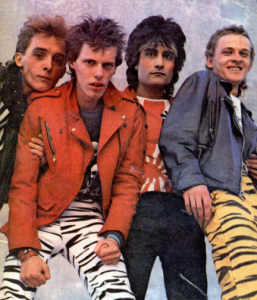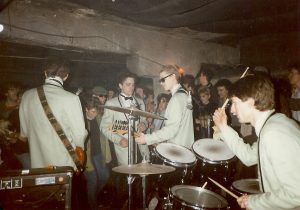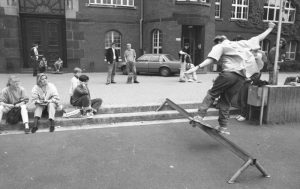Subcultures of the 1980s
Heavy metal

In the first half of the 1980s, long hair, leather rocker jackets (biker jackets) or cut-off denim jackets, tight worn-out jeans, and white, high trainers (sneakers) and badges with logos of favorite metal bands were popular among metalheads, and musicians of heavy metal and speed metal bands. However, by the mid-1980s the success of the glam metal scene had influenced the style worn by many mainstream metal fans. In addition to the traditional denim and leather look, mainstream heavy metal bands began to dress in more bright, colourful and theatrical clothing similar, in many ways, to the glam rock look of the 1970s. This included items such as spandex, platform boots, leg warmers and many different types of often spiked or studded leather accessories. In addition to this the long hair popular with metal fans was often worn teased. Makeup became popular with many metal bands as well often worn onstage for theatricality however many bands also began wearing makeup offstage also.
Punk

Throughout the 1980s, the punk style was popular among people aged 18–22. Characterized by multi-colored mohawks, ripped stovepipe jeans, worn band tee-shirts, and denim or leather jackets. This style was popular among people who listened to punk music such as The Sex Pistols, and later, (despite the band’s self-proclaimed rock’n’roll image) Guns N’ Roses. Usually the denim jackets (which became an identity of the group) were adorned by safety pins, buttons, patches, and several other pieces of music or cultural memorabilia. Oftentimes, fans of the punk style would take random bits of fabric and attach them to their other clothes with safety pins. This soon became a popular way of attaching clothing, and it is now known as “pin shirts” with young women.
New Romantic

The origins of the New Romantic and new wave fashion and music movement of the mid-1980s are often attributed to the Blitz Kids who frequented the club Blitz in London, especially David Bowie. Bowie even used the Blitz’s host Steve Strange in his music video for Ashes to Ashes.[98] The New Romantics and those involved with the punk scene had inspired each other because of the concentration of influential individuals going to the same clubs and having the same circle of friends.[98] Vivienne Westwood and Malcolm McLaren were also directly involved in the movement, such as dressing the members of Bow Wow Wow. The band leader and later solo artist, Adam Ant, and Westwood had highly influenced each other as well (Adam Ant being one of the leading icons of the New Romantics).
Rockabilly

In the early 1980s, the Teddy Boy look was popular in the UK among fans of groups like the Stray Cats, Crazy Cavan, Levi and the Rockats, or Shakin Stevens. Common items of clothing included drape jackets (generally in darker shades than those of the 1970s), drainpipe trousers, brothel creepers, bolo ties, white T-shirts, baseball jackets, hawaiian shirts, and black leather jackets like the Schott Perfecto. Common hairstyles included the quiff, pompadour, flat top, and ducktail.
Rude boys and skinheads
Following on from the mod revival of the late 70s, the UK witnessed a revival of rude boy and skinhead fashion due to the popularity of ska punk, Oi! punk rock, rocksteady, and two tone music during the winter of discontent. In the early 80s, slim fitting mohair, tonic and houndstooth suits[106] were popular, together with basket weave shoes, polo shirts, sta-prest trousers, Doc Martens, braces, Harrington jackets and pork pie hats popularized by bands like the Specials, UB40, the Bosstones, and Madness.[107] In response to the racism of white power skinheads, 1980s rude boys wore checkerboard motifs to signify that both black and white people were welcome. Crew cuts and buzzcuts were worn by both sexes,[108] and girls often incorporated hair bangs in a partially shaven style known as a Chelsea mohawk.[109] In Brighton, the Skins of the 1980s fought the outlaw bikers and rockabilly guys, as the Mods and Rockers had previously done in the 60s.
Casuals
The football casual subculture first appeared in the UK around 1983, when many ex-skinheads began dressing in designer clothing and sportswear to blend into the crowd and avoid police attention at football games. Popular clothing for English and Scottish casuals included Burberry coats, Stone Island, Lacoste, Ben Sherman and Fred Perry polo shirts, tracksuits,[110] bomber jackets, Adidas, Nike, or Reebok sneakers,[111] Fila or Ellesse jackets, flat caps, baseball caps, soccer shirts, and scarfs or bobble hats in their club’s colours.[112] Although shaved heads[113][self-published source?] remained the most common haircut, some fans also wore undercuts, Caesar cuts, mod haircuts, and short mullet haircuts. During the late 80s, Casuals mostly listened to acid house, new wave music, and later indie rock[114] or Madchester[115] but a hip-hop influenced offshoot of the subculture, known as chavs, appeared during the late 1990s and early 2000s.
Skaters

In Russia,[118] Australia, East Germany,[119] and America, the skater subculture reached the height of popularity in the mid-’80s. Unlike the hippie and surfer influenced skaters of the 70s, the skaters of the 80s overwhelmingly preferred sportswear and punk fashion, especially baseball caps, red waffle plaid shirts, sleeveless T-shirts, baggy pants or Jams[120] shorts resembling pajamas,[121] checkered wristbands, striped tube socks, and basketball shoes like Converse All Stars and Vans. Brightly colored T-shirts became fashionable by the end of the decade, often featuring psychedelic eyes, skulls, Ed Roth inspired cartoon characters, palm trees, iron crosses, or the logos of skateboard brands like Stüssy,[122] Tony Hawk, Mooks or Santa Cruz.[123] The longer surfer hair was replaced with edgy hardcore punk and street punk inspired styles like the bowl cut or Hitler Youth haircut.
Rap and hip hop
Sports shoes had been worn as casual wear before, but for the first time they became a high-priced fashion item. Converse shoes were popular in the first half of the 1980s. In 1984, Nike introduced the first ever Air Jordan sneaker, the Air Jordan 1 (named for basketball player Michael Jordan). Although most believe this shoe was banned by the NBA due to the sneaker being too flashy and distracting, others believe it was actually, the predecessor, the Nike Air Ship that was under scrutiny.[124] Nike used this controversy between Air Jordan and the NBA to market the sneaker. The Air Jordan 1 was released in the royal blue color way to the public in 1985 and was an immediate success, still retaining its value in the fashion world today.[125] Soon, other manufacturers introduced premium athletic shoes.
Preppy
Wealthy teenagers, especially in the United States, wore a style inspired by 1950s Ivy League fashion that came to be known as “preppy.” Preppy fashions are associated with classic and conservative style of dressing and clothing brands such as high waisted ankle length jeans and pants plain or pleated, Izod Lacoste, Brooks Brothers, and Polo Ralph Lauren.[132] An example of preppy attire would be a button-down Oxford cloth shirt, Ascot tie, cuffed khakis, and tasseled loafers, Keds, Sperry or Eastland Boat shoes, white Sperry sneakers, or ballet flats. Throughout the 1980s and 1990s, preppy fashions featured a lot of pastels, turtleneck sweaters for girls, knee high socks sometimes turned down or folded over at the top with above the knee length skirts and dresses and polo shirts with designer logos. Other outfits considered “preppy” included cable knit cardigans or argyle pattern sweaters tied loosely around the shoulders.